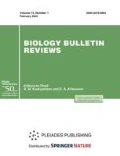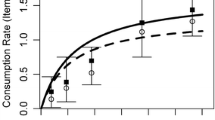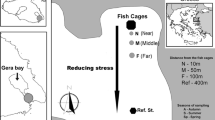Abstract
The fundamental regularities of trophology, such as the dependence of the fish diet on the food concentration, foraging selectivity, and competition for food, which are the key concepts in V.S. Ivlev’s book Experimental Ecology of the Fish Feeding are quite familiar to a broad community of ecologists. However, the range of problems addressed in this milestone study is not limited to the issues of fish trophology. The effect of habitat heterogeneity on biological interactions in ecosystems, which is one of the major objects of research in contemporary ecology, is discussed in the book in two aspects: the connection between the foraging intensity and selectivity to the heterogeneity of prey distribution (the degree of aggregation per Ivlev) and the role of physical obstacles in the regulation of intra- and interspecific competition for food. The dependence of the feeding rate on aggregation was even more substantial than the dependence on prey concentration. Ivlev demonstrated this in laboratory experiments and, which is even more important and difficult, studies of natural water bodies. In this paper, a brief analysis of the ideas and results included in the book and related to the ecological significance of habitat heterogeneity is followed by an overview of a number of modern studies that adhere to Ivlev’s working style and develop his approaches and ideas. It is apparent from these studies that habitat heterogeneity, which is determined by different factors and manifested on different scales, affects both the behavior and the population dynamics of the interacting organisms. As a result, both the mechanisms underlying biological interactions and the structure and functioning of organism communities are modified.


Similar content being viewed by others
REFERENCES
Barry, J.P. and Dayton, P.K., Physical heterogeneity and the organization of marine communities, in Ecological Heterogeneity, Kolasa, J. and Pickett, S.T.A., Eds., New York: Springer-Verlag, 1991, pp. 270–320.
Begon, M., Harper, J.L., and Townsend, C.R., Ecology: Individuals, Populations and Communities, Oxford: Blackwell, 1990, 2nd ed.
Benhamou, S. and Bovet, P., How animals use their environment: a new look at kinesis, Anim. Behav., 1989, vol. 38, pp. 375–383.
Charnov, E.L., Optimal foraging: the marginal value theorem, Theor. Popul. Biol., 1976, vol. 9, pp. 129–136.
Gause, G.F., The Struggle for Existence, Baltimore: Williams and Wilkins, 1934.
Grant, J.W.A., Territoriality, in Behavioral Ecology of Teleost Fishes, Oxford: Oxford Univ. Press, 1997, pp. 81–103.
Hanski, I., Metapopulation Ecology, New York: Oxford Univ. Press, 1998.
Hassell, M.P., The Spatial and Temporal Dynamics of Host-Parasitoid Interactions, Oxford: Oxford Univ. Press, 2000.
Hassell, M.P. and May, R.M., Aggregation of predators and insect parasites and its effect on stability, J. Anim. Ecol., 1974, vol. 43, pp. 567–594.
Hildrew, A.G. and Townsend, C.R., Aggregation, interference and foraging by larvae of Plectrocnemia conspersa (Trichoptera: Polycentropodidae), Anim. Behav., 1980, vol. 28, pp. 553–560.
Holling, C.S., Some characteristics of simple types of predation and parasitism, Can. Entomol., 1959, vol. 91, pp. 385–398.
Huffaker, C.B., Experimental studies on predation: dispersion factors and predator-prey oscillations, Hilgardia, 1958, vol. 27, no. 14, pp. 343–383.
Hunter, J.R., Swimming and feeding behavior of larval anchovy Engraulis mordax,Fish. Bull., 1972, vol. 70, pp. 821–838.
Hunter, J.R. and Thomas, G.L., Effect of prey distribution and density on the searching and feeding behavior of larval anchovy Engraulis mordax, in The Early Life History of Fish, Blaxter, J.H.S., Ed., Berlin: Springer-Verlag, 1974, pp. 559–574.
Hutchinson, G.E., The paradox of the plankton, Am. Nat., 1961, vol. 95, pp. 137–145.
Ivlev, V.S., Hunting period and the path traveled by the predator related with the population density of the victim, Zool. Zh., 1944, vol. 23, no. 4, pp. 139–145.
Ivlev, V.S., Food utilization by fishes-plantonophages, Tr. Sevastop. Biol. Stn., 1961a, vol. 14, pp. 43–61.
Ivlev, V.S., Experimental Ecology of the Feeding of Fishes, New Haven: Yale Univ. Press, 1961b.
Krause, J. and Ruxton, G.D., Living in Groups, Oxford: Oxford Univ. Press, 2002.
Lasker, R., Field criteria for the survival of anchovy larvae: the relation between inshore chlorophyll maximum layers and successful first feeding, Fish. Bull., 1975, vol. 73, pp. 453–462.
Levin, S.A., Patchiness in marine and terrestrial systems: from individuals to populations, Philos. Trans. R. Soc., B, 1994, vol. 343, pp. 99–103.
Levins, R., Some demographic and genetic consequences of environmental heterogeneity for biological control, Bull. Entomol. Soc. Am., 1969, vol. 15, pp. 237–240.
Lotka, A., Elements of Physical Biology, Baltimore: Williams and Wilkins, 1925.
Manteifel’, B.P., Ekologiya povedeniya zhivotnykh (Ecology of Animal’s Behavior), Moscow: Nauka, 1980.
Mikheev, V.N., Change of availability of invertebrates due to change of their behavior for fish juveniles, Trudy IV Vsesoyuznoi konferentsii po povedeniyu vodnykh bespozvonochnykh (Proc. IV All-Union Conf. on Behavior of Aquatic Invertebrates), Borok: Inst. Biol. Vnutr. Vod, 1986, pp. 18–22.
Mikheev, V.N., Foraging behavior of fishes and habitat complexity: searching, prey selection and conflict of motivations, J. Ichthyol., 2000, vol. 40, suppl. 2, pp. 262–270.
Mikheev, V.N., Neodnorodnost’ sredy i troficheskie otnosheniya u ryb (Heterogenity of Environment and Trophic Relations of Fishes), Moscow: Nauka, 2006.
Mikheev, V.N. and Pakul’skaya, D.S., Motion activity in food searching behavior of larvae of Hemigrammus caudovittatus,Vopr. Ikhtiol., 1988, vol. 28, no. 6, pp. 1007–1013.
Mikheev, V.N. and Pavlov, D.S., Ethological and bioenergetic approaches to fish trophology, Zool. Zh., 2005, vol. 84, no. 10, pp. 1202–1220.
Mikheev, V.N., Pavlov, D.S., and Pakulska, D., Swimming response of goldfish, Carassius auratus, and the tetra, Hemigrammus caudovittatus, larvae to individual food items and patches, Environ. Biol. Fish., 1992, vol. 35, pp. 351–360.
Mikheev, V.N., Bobyrev, A.E., Kriksunov, E.A., and Mikheev, A.V., Food search strategies of juvenile fishes: analysis of a mathematical model, Vopr. Ikhtiol., 1997, vol. 37, no. 2, pp. 242–247.
Mikheev, V.N., Afonina, M.O., and Pavlov, D.S., Habitat heterogeneity and fish behavior: units of heterogeneity as a resource and as a source of information, J. Ichthyol., 2010, vol. 50, no. 5, pp. 386–395.
Murdoch, W.W., Swarbrick, S.L., Luck, R.F., Walde, S., and Yu, D.S., Refuge dynamics and metapopulation dynamics: an experimental test, Am. Nat., 1996, vol. 147, pp. 424–444.
Radakov, D.V., Stainost’ ryb kak ekologicheskoe yavlenie (Fish Flocking as Ecological Phenomena), Moscow: Nauka, 1972.
Solomon, M.E., The natural control of animal populations, J. Anim. Ecol., 1949, vol. 18, pp. 1–35.
Vinberg, G.G., Life and scientific activities of Viktor Segeevich Ivlev (1907–1964), in Eksperimental’naya ekologiya pitaniya ryb (Experimental Ecology of Fish Feeding), Kiev: Naukova Dumka, 1977, pp. 243–265.
Vlymen, W.J., A mathematical model of the relationship between larval anchovy (Engraulis mordax) growth, prey microdistribution, and larval behavior, Environ. Biol. Fish., 1977, vol. 2, pp. 211–233.
Volterra, V., Variations and fluctuations of the numbers of individuals in animal species living together, ICES J. Mar. Sci., 1928, vol. 3, no. 1, pp. 3–51.
Funding
The study was performed with financial support from the Russian Science Foundation, project no. 14-14-01171P (analysis of publications and manuscript writing), and the Russian Foundation for Basic Research, project no. 17-04-00247a (analysis and arrangement of the materials).
Author information
Authors and Affiliations
Corresponding author
Ethics declarations
Conflict of interests. The authors declare that they have no conflicts of interest.
Statement on the welfare of animals. This article does not contain any studies involving animals performed by any of the authors.
Additional information
Translated by S. Semenova
Rights and permissions
About this article
Cite this article
Mikheev, V.N. V.S. Ivlev’s Monograph Revisited. The Role of Habitat Heterogeneity in Biological Interactions. Biol Bull Rev 10, 11–18 (2020). https://doi.org/10.1134/S2079086420010053
Received:
Published:
Issue Date:
DOI: https://doi.org/10.1134/S2079086420010053




